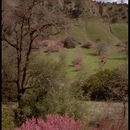More info on this topic. More info for the terms:
climax,
forest,
fruit,
hardwood,
mesic,
relative dominance,
successionFacultative Seral Species
Eastern redbud is moderately tolerant of shade and grows well in full
sun. Flower and fruit production is best in full sun, but eastern
redbud's tolerance of full sunlight decreases in hot and dry areas
[
50,
54]. It has been hypothesized that eastern redbud and similar
midstory trees such as flowering dogwood attain a midstory canopy height
that maximizes interception of sunflecks (transitory periods of full sun
created by gaps in the canopy and the angle of the sun). If this is the
case, eastern redbud requires at least short periods of sunlight for
growth [
54].
Eastern redbud apparently establishes in middle seres, forming a
midstory layer, often with flowering dogwood. In North Carolina,
eastern redbud and flowering dogwood developed as a distinct midstory
under an oldfield shortleaf pine (Pinus echinata) canopy as the stand
approached middle age (85 years) [
7]. In western Tennessee, eastern
redbud was recorded on 28-year-old abandoned agricultural fields, but
not recorded on 3- and 12-year-old sites [
48]. In Texas, primary
succession in gravel pit excavations did not include eastern redbud even
on the 47-year-old site, although eastern redbud was present in adjacent
undisturbed forest [
60]. Eastern redbud is a characteristic midstory
species in mesic southern mixed hardwood forests which succeed
pine-hardwood mixtures, and could therefore be classed as a
late-successional species [
43]. It occurs, for example, in an
old-growth oak forest in northwestern Ohio [
61] and it is present as
seedlings, saplings and mature trees in southern mixed hardwood forest
in north-central Florida [
38]. It may not, however, be stable in some
climax communities: eastern redbud was reported as decreasing in
importance and relative dominance in an oldgrowth oak (Quercus
spp.)-hickory (Carya spp.) forest in Illinois [
49].
Although eastern redbud is not usually described as a pioneer species it
often increases in dominance on sites experiencing disturbance. It is
common on cutover or windthrown areas on calcareous soils [
35]. In
Indiana, a tornado caused severe windthrow in a sugar maple (Acer
saccharum)-Ohio buckeye (Aesculus glabra) stand. Prior to the tornado,
eastern redbud was a minor component in the stand. The most severely
damaged portion of the forest was still mostly open 7 years after the
disturbance and was dominated by sugar maple, elms (Ulmus spp.), Ohio
buckeye, and eastern redbud. Eastern redbud, which increased
dramatically in the first years after the tornado, will probably decline
in importance as taller species begin to close the canopy [
35].

